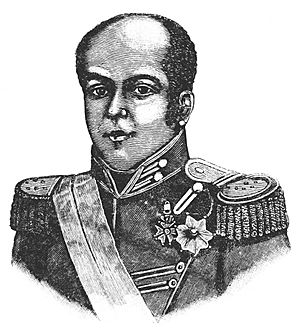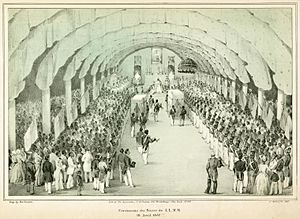Faustin Soulouque facts for kids
Quick facts for kids Faustin I |
|||||
|---|---|---|---|---|---|
 |
|||||
| Emperor of Haiti self-proclaimed |
|||||
| Reign | 26 August 1849 – 15 January 1859 | ||||
| Coronation | 18 April 1852 | ||||
| Predecessor | Himself (as President of Haiti) |
||||
| Successor | Fabre Geffrard (as President of Haiti) | ||||
| 7th President of Haiti | |||||
| In office | 1 March 1847 – 25 August 1849 | ||||
| Predecessor | Jean-Baptiste Riché | ||||
| Successor | Himself (as Emperor of Haiti) |
||||
| Born | 15 August 1782 Petit-Goave, Saint-Domingue |
||||
| Died | 3 August 1867 (aged 84) Anse-à-Veau, Haiti |
||||
| Spouse | Adélina Lévêque | ||||
| Issue | Princess Olive Princess Célita |
||||
|
|||||
| House | Soulouque | ||||
| Father | Taneau Coichi | ||||
| Mother | Marie-Catherine Soulouque | ||||
Faustin-Élie Soulouque (born August 15, 1782 – died August 3, 1867) was an important Haitian leader. He served as the President of Haiti from 1847 to 1849. Later, he became the Emperor of Haiti from 1849 to 1859, ruling as Faustin I.
Soulouque started as a general in the Haitian Army. When he became president, he quickly gained a lot of power. He made sure his loyal supporters, especially black Haitians, were in important government and army jobs. He also created a special police force.
Faustin I was crowned Emperor in 1852. He tried several times to take back the Dominican Republic, which had become independent from Haiti. These attempts were not successful and made him lose support. In 1859, he gave up his throne under pressure from General Fabre Geffrard. Soulouque went to Jamaica for a while before returning to Haiti, where he died in 1867.
He was a unique figure in Haitian history. Soulouque was the last Haitian head of state who had fought in the Haitian Revolution. He was also the last leader born before Haiti became independent. He was the last former slave to rule Haiti and the last to call himself a king or emperor.
Contents
Early Life and Military Career
Faustin-Élie Soulouque was born on August 15, 1782. This was in Petit-Goâve, a small town in the French colony of Saint-Domingue (now Haiti). His mother, Marie-Catherine Soulouque, was born in Port-au-Prince. She was a Creole woman of Mandinka heritage.
In 1793, slavery was abolished in Saint-Domingue. This happened because of a decree during the French Revolution and the ongoing Haitian Revolution. Soulouque gained his freedom at this time.
In 1803, Soulouque joined the revolutionary army. He fought as a private soldier. The conflict ended in 1804, and Saint-Domingue became independent Haiti. Soulouque was a respected soldier. He became a lieutenant in the Haitian Army in 1806. He also served as an aide-de-camp to General Lamarre.
For the next forty years, Soulouque continued to serve in the military. He rose through the ranks under different presidents. He became a colonel and then a lieutenant general. Eventually, he became the Supreme Commander of the Presidential Guards.
Becoming Emperor of Haiti
In 1847, President Jean-Baptiste Riché died. The powerful ruling class, known as the Boyerists, looked for a new president. They chose Soulouque because they thought he would be easy to control. Soulouque, who was 65 years old, accepted the role. He became Haiti's 7th President on March 2, 1847.
At first, Soulouque seemed to follow their plans. He kept the same government ministers and continued the previous president's programs. However, he soon surprised everyone. Soulouque began to take complete control of Haiti.
He created his own private army called the Zinglins. He used them to arrest or remove anyone who opposed him. This helped him gain full power over the government. Soulouque also favored Haiti's black population. He invited black people from Louisiana to move to Haiti.
Soulouque put strict limits on anyone who disagreed with him. This led to violence against his potential rivals. He also openly practiced Vodou, a traditional Haitian religion. He even had Vodou priests and priestesses living at his home in Port-au-Prince.
The Coronation Ceremony
Soulouque's journey to absolute power ended with the creation of the Second Empire of Haiti. On August 26, 1849, the Senate and Chamber of Deputies declared him Emperor of Haiti. He took the name Faustin I. This brought back the Haitian monarchy, which had ended in 1806.
Faustin I spent a lot of money on his coronation. He paid £2,000 for his crown and £30,000 for other royal items. He wanted everything to be like the coronation of Napoleon in France. He ordered a crown for himself and one for his wife, the Empress. He also got a scepter, a globe, a hand-of-justice, and a throne.
In December 1849, Faustin married his long-time partner, Adélina Lévêque. On April 18, 1852, the Emperor and Empress were crowned in a huge and fancy ceremony in Port-au-Prince. It was a grand event, just like Napoleon's coronation.
Creating a Haitian Nobility
Faustin I wanted to create a strong centralized government. He took ideas from European traditions, especially from the French Empire. One of his first actions as emperor was to create a Haitian nobility. The Constitution of September 20, 1849, allowed him to create hereditary titles.
His empire included many nobles. There were 4 princes, 59 dukes, 90 earls, and 250 barons. He also created special awards to honor loyalty to his rule. These included the Military Order of St. Faustin and the Civil Order of the Haitian Legion of Honor. Later, he created the Orders of St. Mary Magdalene and St. Anne in 1856. That same year, he founded the Imperial Academy of Arts.
Foreign Policy and Challenges
Faustin I's foreign policy focused on keeping other countries from interfering in Haiti's affairs. His biggest challenge was the Dominican Republic. It had gained independence from Haiti in 1844. Faustin I saw this independence as a threat to Haiti's safety.
In 1849, Soulouque launched his first invasion of the Dominican Republic. However, his army retreated after a small fight. A second invasion in 1850 was stopped by other countries like the United Kingdom, France, and the United States. In his third and final invasion in 1855, Soulouque led a large army of 30,000 men. But his army fled at the first sign of resistance.
Soulouque also faced issues with the United States over Navassa, an island. The U.S. had taken the island because a valuable mineral called guano was found there. Soulouque sent warships to the island. However, he withdrew them after the United States promised Haiti a share of the money from the mining.
Historians have different views on Faustin Soulouque. Some believe he was a very smart and practical leader. They say he was a strong politician and diplomat. They also agree that he was very patriotic and brought peace to Haiti during his rule.
Known Ministers
- Louis Dufresne (general of the army, minister of war, navy, and foreign relations)
- Jean-Baptiste Francisque (minister of justice, worship, and public education)
- Lysius Salomon (Finance, Commerce, and Foreign Relations)
Family and Succession
Faustin I and Empress Adélina had one daughter, Princess Célita Soulouque. The emperor also adopted Adélina's other daughter, Olive, in 1850. She was given the title of Princess. Princess Célita married Jean Philippe Lubin, Count of Pétion-Ville, and had children.
The Constitution of September 20, 1849, stated that the title of Emperor would pass down through Faustin I's direct male descendants. The Emperor could also adopt his brothers' children or grandchildren. These adopted sons could then inherit the throne after the Emperor's own sons.
Faustin's brother, Prince Jean-Joseph Soulouque, had many children. Jean-Joseph's oldest son, Prince Mainville-Joseph Soulouque, was named the Prince Imperial of Haiti. This meant he was the heir to the throne after his uncle became emperor.
Exile and Later Life
In 1858, a revolution against Soulouque began. It was led by General Fabre Geffrard. In December of that year, Geffrard's army defeated Soulouque's forces. Geffrard took control of most of Haiti.
On the night of December 20, 1858, Soulouque left Port-au-Prince by boat. He was with his son and two loyal followers. Two days later, they arrived in Gonaives, where the revolution had started. The Republic of Haiti was declared again, and a new constitution was adopted.
On December 23, Faustin Soulouque was removed from his position. Fabre Geffrard was appointed President of Haiti. Many parts of the country joined in restoring the Republic. As a result, Soulouque gave up his throne on January 15, 1859. He was refused help by the French. On January 22, 1859, a British warship took Soulouque and his family into exile.
Soulouque and his family arrived in Kingston, Jamaica. They lived there for several years. Some records say he died in Kingston. However, according to Haitian historian Jacques Nicolas Léger, Soulouque returned to Haiti at some point. He died in Petit-Goave in August 1867.
Images for kids
See also
 In Spanish: Faustino I de Haití para niños
In Spanish: Faustino I de Haití para niños



